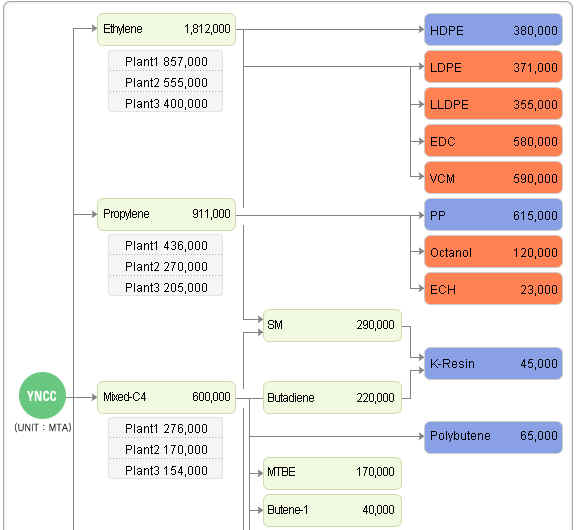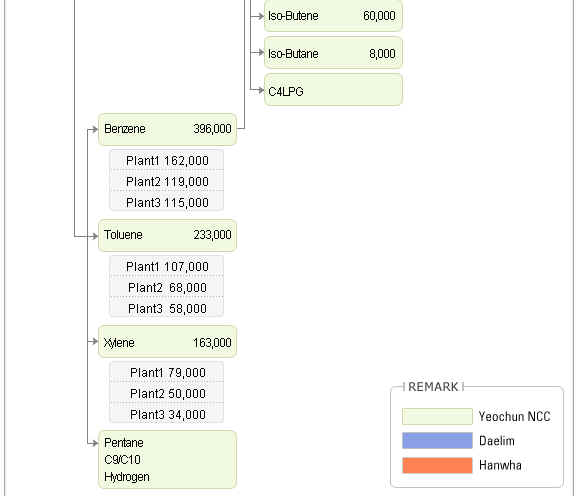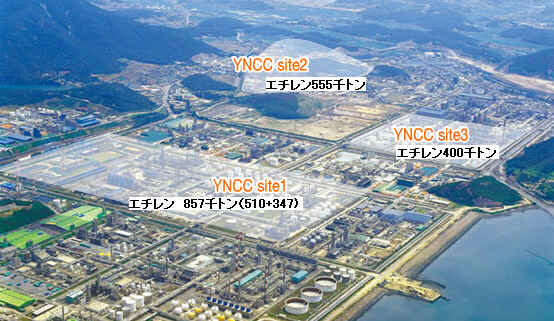Hanwha Chemical
Corporation 歴史
Hanwha Acquires AZDEL, Inc. from
SABIC Innovative Plastics, PPG Industries
| |
|
2007/2現在 Ethylene plant1: 857千トン(510+347) |
| 麗川NCC:ハンファ、大林 JV 単位:千トン
| |
SK 蔚山 |
大林産業 麗川 |
ハンファ 麗川 |
| C2 |
SK |
730
|
麗川NCC |
800
|
麗川NCC |
500
|
| HDPE |
|
|
大林産業 |
380
|
|
|
| L-LDPE |
|
|
|
|
ハンファ |
350
|
| LDPE |
ハンファ |
85
|
ハンファ
(大林から) |
120
|
ハンファ |
165
|
| EDC |
ハンファ |
150
|
|
|
ハンファ |
430
|
| VCM |
ハンファ |
216
|
|
|
ハンファ |
300
|
| PVC |
ハンファ |
210
|
|
|
ハンファ |
205
|
| SM |
|
|
麗川NCC
|
140
→285
|
|
|
| C3 |
|
|
麗川NCC |
455
|
麗川NCC |
250
|
| ブタジェン |
|
|
麗川NCC |
120
|
|
|
| MTBE |
|
|
麗川NCC |
150
|
|
|
|
 |
 |
http://hcc.hanwha.co.kr/english/english_1.htm
The Hanwha Group was established
from Korea Explosives Co., Ltd. in 1952, starting out by engaging
the petrochemical business. Korean economy was rapidly
industrializing in the 1960s, and the Hanwha Group was an
important driver of national ecnomic development. In the 1970s.
Hanwha developed its petrochemical and machinery operations and
expanded into trade, construction, food and retailing. In the
1980s, the group realized strong qualitative and quantitative and
growth, while resolute and progressive restructuring has enabled
Hanwha to remain healthy and strong in the 1990s.
Hanwha Chemical Corporation laid the groundwork for Korea’s debut into the Worldwide chemical
industry, when it pioneered PVC, LDPE, LLDPE, and Chlor-Alkali
manufacturing in Korea.
Following the currency crisis in Asia, Hanwha Chemical underwent
massive restructuring. In July 1999 it spun off processed goods
division, and then in December 1999 established a naphtha cracker joint
venture
and concluded a swap deal with Daelim for their Polyolefin
business in order to maximize
competitiveness in its core business.
Having a firm position in
domestic market in terms of its core business field
(Chlor-Alkali, Polyethylene, PVC), Hanwha Chemical aims to
enhance its competitive edge to a world-class level, while
searching, developing, and commercializing new non-commodity
chemicals. Also, Hanwha plans to make life science and e-business
as its new growth engine in the new century.
PE Division :
In 1972, Hanwha Chemical
Corporation(HCC), a pioneer in the polyethylene industry,
became the first company to produce polyethylene in Korea.
In 1999,
through a business swap, HCC took over the LDPE and L-LDPE
businesses of Daelim Industrial Co. and became the biggest
manufacturer in Asia.
Hanwha polyethylene plants currently produce 720 thousand
tons of LDPE and LLDPE annually.
Products:
LDPE
Hanwha plants produce 370
thousand tons of LDPE annually. Hanwha Chemical
Corporation(HCC) has various processes, including the
tubular process and autoclave process developed by DOW
and the autoclave process developed by ICI.
EVA
Hanwha Chemical
Corporation(HCC) began producing EVA based on its own
technology in 1986.
With the autoclave and tubular processes developed by
DOW, HCC produces various grades, covering a wide range
of VA content to meet the customer's stringent
requirements.
LLDPE
Hanwha LLDPE plants
produce 350 thousand tons annually using the Unipol gas
phase process of UCC and the Spherilene gas phase process
of Montell.
W&C Compound
Hanwha Chemical
Corporation(HCC) began producing the Wire & Cable
Compound based on its own technology in 1982.
Hanwha W&C Compound, a high performance composite
consisting of polyolefin and functional additives, is
well known for its various products and high quality. We
have 60% share of W&C Compound market in Korea.
We also have specialty products for foamed insulations
and halogen-free flame retardant sheaths.
PVC Division:
Hanwha Chemical Corporation
has firmly established a reputation for superior technology
and quality in the production of PVC since it first
introduced its products.
PVC (Polyvinyl chloride) is widely used as a raw material for
diverse products such as pipe, sheets, and compounds to daily
necessities like wallpaper, toys, and erasers.
Products :
PVC Resin
Since it became the first
Korean PVC manufacturer in 1966, Hanwha Chemical
Corporation has led the Korean PVC industry with
continuous quality improvement and innovative
development. It has supplied the industry with various
grades covering diverse applications such as pipe, sheet,
and compound.
Paste Resin
Hanwha Chemical
Corporation is meeting customer needs by producing
various grades of MSP resin, Blend resin, and Emulsion
resin and is making every effort to provide stable supply
while also seeking to promote new product development.
Plasticizer
Plasticizer is a raw
material used to adjust the plasticity of PVC processed
goods such as flexible applications and compounds. It
alters the quality and characteristics depending on
applied quantity.
Hanwha Chemical Corporation produces 90,000MT per year
and is expanding rapidly to keep up with the development
of PVC industry.
Chlor-Alkali Division :
Today,
HCC leads Korea's current Chlor-Alkali market and is involved
in activities from the production to sales of Caustic Soda
and Chlorine Derivatives.
Products:
ECH, HYPO, Chlorine, HCI,
NaOH, EDC, VCM, NH4CI, H2
OA (Oxo Alcohol) Division :
Just
as alcohol is ubiquitous in our lives, so is it in PVC
converting industries.
O.A Division, with cutting-edge technology, has been
providing alcohol products for use in plasticizers, a crucial
ingredient in PVC-processed goods.
Products:
2-Ethyl Hexanol, Butanol
and the related
関係会社
Yeochun NCC
Ethylene, Propylene, Benzene, Toluene,
Xylene, Mixed C-4, etc 製品
Established
in Dec 1999
(Joint Venture between Hanwha Chemical
and Daelim, 50:50)
Daelim and
Hanwha decided to merge their naphtha cracking centers to
boost efficiency and international competitveness in the new
millennium. Yeochun NCC, a 50:50 joint venture, is well
positioned to be a world-class petrochemical company with the
combined technology, management know-how and organizational
strengths of Daelim and Hanwha.
Yeochun NCC, located
in the Yeochun Petrochemical Complex, has the most advanced
facilities, including three fully-automated naphtha cracking
centers, turning out high-purity products through advanced
process control. The company is contributing to Korean
economic development by supplying 1.3 million tons of
ethyline, 705,000 tons of propylene and 1.5 million tons of
other downstream products a year. (http://www.yncc.co.kr/)
| 2007年02月15日
Chemnet Tokyo |
| YNCCの増設プラントが稼動を再開 |
| |
大手商社筋によると、韓国のエチレンセンターの一つであるYNCCは先週末に年産35万トン能力のエチレン新プラントの本稼動を再開した。
今回再稼動したエチレン装置は既存の第1号機に追加建設したもので、昨年10月に完工したもののメカニカル面の小トラブルが相次ぎ発生して安定操業に移行できない状態が続いていた。そこで今年に入り全面運休して抜本的な対策を講じたところ、高率操業を維持していける見通しが立ったため再稼動に踏み切ったもの。
YNCCのホームページではエチレン能力を1812千トン
内訳は ①857千トン(510+347)、②555千トン、③400千トン
APIC2006の資料では1465千トン(
①510千トン、②555千トン、③400千トン)
|

2004年9月6日 中国・ASEANニュース速報
【韓国】麗川NCC、SM設備を大幅拡充
http://www.e-plastics.gr.jp/japanese/nna_news/news/news0409_2/04090603.htm
石油化学素材メーカーの麗川NCCが、スチレンモノマー(SM)の生産設備を約2倍に増設する計画を明らかにした。総工費380億ウォンを投じ、来年10月の完成を目指す。
増設が完了すれば、年産規模は現在の14万2,000トンから28万トンに拡大。サムスンアトフィナ(年産67万トン)、LG化学(同50万トン)、現代石油化学(39万トン)などに次ぎ、SM生産で業界6位に浮上する。
同社はまた、国内最大の生産能力(年産143万トン)を持つエチレン設備の増設計画も推進中だ。
Platts
2005/8/24 計画
S Korea's Yeochon
plans SM expansion despite poor margins 麗川NCC
South Korea's Yeochon NCC plans to proceed with its
styrene monomer plant expansion in October despite being
dogged with poor margins for the past two years, a source
close to the firm said Wednesday. Yeochon is slated to boost
its plant capacity in Yeochon to 285,000
mt/yr from 140,000 mt/yr during a 40-day outage
scheduled for Oct 20 through Nov 30. Another local SM
producer, Dongbu Chemical, has postponed
its debottlenecking project from October to early next
year.
Hanwha Living and
Creative Corp.
Flooring, Window,
Home Door, PVC Compound, Film & Sheet, GMT, EPP,
Upholstery, SMC, Conpanel, Hanex, Decor Sheet, etc
Established in Jul 1999
(100% owned by Hanwha Chemical)
Hanwha Advanced Material
Co., Ltd
Woodstock,
etc
Established in Jun 1988
(Joint Venture between Hanwha Chemical and Solvay, Belgium,
50:50)
Hanwha
Polymer Co., Ltd
Tarpaulin,
etc
Established in Sep 1974
(61.3% stake by Hanwha Chemical Corp.)
ハンファ
In 1952,
the Hanwha Group was founded under the name, Korea Explosives
Corporation. The founding chairman, Kim Jong-hee, had built the
explosives company from the ruins of the Korean War with a sense
of duty, to build a patriotic business that could contribute to
the rebirth of the national economy.
He believed that in
order to achieve rapid recovery in the basic industries of a
devastated country, explosives production was needed above
everything. As Korea's only private powder plant, Korea
Explosives Co. showed remarkable growth to become one of Asia's
leading explosives suppliers within ten years. The monumental
step taken by Korea Explosives Co., which had risen in an area no
one else dared to harness, was the very starting point of today's
Hanwha Group.

韓国火薬
| Oct.1952 |
|
Founded Korea
Explosives Corporation |
| Oct.1955 |
|
Bought over
Inchon Power Plant |
| Oct.1957 |
|
Succeeded in
test production of NG (Nitro-Glycerin) |
| Jun.1958 |
|
Started to
produce dynamite |
| Aug.1965 |
|
Established
Korea Hwasung Industrial Co., Ltd. |
| Nov. 1969 |
|
Established
Kyungin Energy Co.,Ltd. |
| Dec.
1972 |
|
Korea
Hwasung Industrial Corp. was merged into Korea
Plastics Industrial Corp.
according to the government's policy to merge 5 PVC
companies. |
| Dec. 1979 |
|
Took over Korea
Plastics Industrial Corp. |
| Dec. 1982 |
|
took over
management rights of Dow Chemical Korea |
| Jan.
1984 |
|
Merged Hanyang
Chemical, Hanyang Chemical Corp, and Hanyang. Electronics
& Chemical into Hanyang Chemical |
| May 1988 |
|
Merged Hanyang
Chemical and Korea Plastics |
| Oct. 1998 |
|
Sold 'PMMA'
sector of Hanwha General Chemical to ATO, France |
韓洋化学
1966 Daehan Plastics (芙江)
信越技術(カ-バイド法)
現状:塩ビ加工工場(塩ビ工場は
scrap)
1967 Kongyoung Chemicals (蔚山)鐘化技術
現状:サス
146千トン、ペ-スト 50 千トン
1968 Korea Chemical(鎮海) 日本カ-バイド技術
現状:サス
48千トン
1969 Woopoong Chemical (群山) 鐘化技術
現状:サス
36千トン、ペ-スト 2.2千トン
1969 Tongyang Chemical (仁川) 現状 閉鎖
↓
↓
1972 上記5社の合併 ---韓国プラスチック
1969 Korea Pacific Chemical(麗川) ダウ技術(電解/EDC/VCM)
Dow/韓国総合化学
1990 鐘化技術 PVC 80千トン
1974 韓国火薬が韓国総合化学の政府持株を継承(Korea
Pacific Chem Holding Co)
1982 韓国火薬が Korea Pacificのダウ持株および韓国ダウを買収
1984 Korea Pacific Chem Holding, Korea Pacific Chem, Dow
Korea を合併し、韓洋
化学と改称
1988 韓洋化学が韓国プラスチックを吸収合併
1994 ハンファと改称
2004-3-5 Asia Chemical
Weekly
S Korea's Hanwha aiming to become
global top-10 PVC player
South Korea's Hanwha Chemical
Corp is planning to invest at least Won300bn
($256.3m/Euro210.1m) by 2007 to help build the company into
one of the world's top-ten polyvinyl chloride (PVC)
producers, a company spokesman said.
Hanwha is studying the feasibility of building new PVC plants
and lines, both in South Korea and China, but has yet to
decide on the locations or size of the facilities.
November
19, 2007 AZDEL
Hanwha Acquires
AZDEL, Inc. from SABIC Innovative Plastics, PPG Industries
Hanwha Living
& Creative (L&C) Corporation announced today that it has
finalized the acquisition of AZDEL
Inc.,
a 50/50 joint venture of SABIC
Innovative Plastics (formerly GE Plastics) and PPG Industries. The acquisition of
AZDEL will allow Hanwha to expand its offering of composite and
advanced material solutions for the transportation and industrial
segments. Terms were not disclosed.
| Hanwha
Living and Creative Corp. Established
in Jul 1999
(100% owned
by Hanwha Chemical)
Products:Flooring,
Window, Home Door, PVC Compound, Film & Sheet,
GMT, EPP, Upholstery, SMC, Conpanel,
Hanex,
Decor Sheet, etc
|
Going forward,
AZDEL has entered into a long-term strategic supply arrangement
with SABIC Innovative Plastics and PPG Industries, whereas SABIC
Innovative Plastics will supply thermoplastic resins to AZDEL and will
continue to work with AZDEL through a joint development agreement
to bring new innovative products to the industry. In the same
way, PPG will continue to supply
fiberglass reinforcement materials to AZDEL under a long-term supply
agreement.
朝鮮日報 2007/11/21
アズデル社は1972年に設立された高機能複合素材のメーカーで、自動車のバンパーの材料となるGMT、天井部分の内張りなどに使われるLWRTなどの分野において全米1位のメーカーだ。ハンファ・グループは「金升淵(キム・スンヨン)会長が今年1月、海外進出に関する戦略会議で、現在10%にとどまっている海外事業の売り上げを2011年までに40%に引き上げるという目標を打ち出して以来、初めて目に見える結果を導き出した」と話している。アズデル社の買収により、ハンファL&Cは世界最大のGMTメーカーとなり、自動車の部品や素材を全世界の自動車メーカーに供給できるグローバルネットワークの基盤を形成することになった、と同グループでは説明している。
AZDEL is a global
leader in the manufacture and supply of high-performance
thermoplastic composite materials serving a wide variety of
markets and industries including automotive, large truck,
materials handling, HVAC, and building & construction.
Joint Venture company between GE Advanced Materials and PPG,
Inc. - A fusion of two of the most successful companies in
the world.
Backed by the extensive sales and marketing resources of GEAM
throughout the globe, along with the glass-fiber technology
offered by PPG, AZDEL provides one of the most
comprehensive product portfolios in the thermoplastic
composites industry.
* The AZDEL Business was
established in 1972 by PPG.
* GE entered the business in 1986 to create a 50/50 joint
venture.
* A fusion of the two most successful companies in the world.
* The world's leading supplier of Glass Mat Thermoplastics
(GMT).
* Backed by extensive sales, marketing, and application
development efforts of GE Plastics throughout the
globe.
* The largest product portfolio in the GMT industry
* Materials and processes to suit both interior &
exterior structural applications across many different
industries.
AZDEL SuperLite®
A low pressure,
thermoformable composite of polypropylene and long chopped
fiber combined with outer layers as needed for the
application (i.e.; adhesive film, barrier film, tough PP
film, non-woven, reinforcing, or just the bare surface.)
AZDEL Laminate®
GMT
Also
known as Glass Mat Thermoplastic, or GMT, AZDEL Laminate is a
five layer composite of glass fiber and thermoplastic resin.
Usually compression molded in a process similar to SMC, this
material may also be thermoformed using several industry
standard methods of production.
宇部日東化成
1982年 岐阜工場でPPGより技術導入し熱可塑性スタンバブルシートアズデル生産開始
1999年 出光石油化学、日本板硝子と日本GMT設立し、移管
(1)宇部日東化成は、昭和57年にスタンパブルシートの生産を開始、以来現在に至るまで当該事業を展開してきた。
(2)出光石油化学及び日本板硝子は、昭和62年に折半出資で出光エヌエスジー(株)(注3)を設立し、スタンパブルシート事業を共同で展開してきた。
(3)しかしながらここにきて、当該製品の主力用途である自動車部品向けは輸入品や他素材(鉄、アルミ等)との競争が激化、一方の産業資材部品向けについても昨今の厳しい経済状況を受け、販売数量の減少等により業績が低迷、両社ともに抜本的なコスト合理化策を検討中であった。
(4)また、当該事業は大幅な設備過剰環境下にあり(国内生産能力20千トン/年に対し推定需要7千トン/年)、両社ともに低稼動を余儀なくされている。
(5)今般、三社共同出資による合弁新会社を設立し、宇部日東化成及び出光エヌエスジ-のスタンパブルシート事業を新会社に引き継ぎ、両社の生産・販売・研究開発の融合による事業競争力の強化と需給ギャップの解消を図ることとした。
2011/4/11 朝鮮日報
ハンファ・ケミカル、太陽光設備に1兆ウォン超投資
ハンファ・ケミカルは11日、太陽光発電事業の中長期運営基盤の安定化と収益向上を目指し、ポリシリコン製造設備に1兆357億7600万ウォン(約809億円)を投資することを決めた。これは、昨年末の自己資本比率34.55%に当たる。投資期間は2013年7月31日まで。
2013/12/20 朝鮮日報
ハンファ・ケミカルがイラク進出
ハンファ・ケミカルは原価競争力を確保するため、韓国の石油化学業界で初めてイラク進出を推進することを19日、明らかにした。40億ドル(約4170億円)を投資し、イラク南部にエチレン生産設備や石油化学製品生産工場などを建設する計画だ。ハンファは同日、ソウル市中区の同社ビルで、イラク産業省次官と以上の内容の合弁事業意向書を締結した。今後はイラク政府と具体的に事業性を検討していく予定だ。
ハンファがイラク市場に進出するのは、低コストの原料をほかに先駆けて確保するためだ。石油の産地に大規模な生産基地を建設し、中東・北米製品と同等の原価競争力を得ようという戦略だ。
ハンファ・ケミカル関係者は「イラクは低価格の原料が豊富なうえ、石油化学産業が未成熟な地域なので、ほかに先駆けて確保すればその効果はより大きいと見ている」と述べた。
Hanwha Chemical said today that it has signed
a letter of intent (LOI) to build a petrochemical complex in Iraq. The LOI was
signed at Seoul by the company’s president, Han-hong Bang; and Iraq’s deputy
minister of industry, Mohammed Zain. The complex will require an investment of
about $4 billion and include gas processing facilities,
ethylene, and other petrochemical production units, with a combined
capacity of 1 million m.t./year of petrochemicals. Completion is expected in
2020–21, the company says.
These facilities will be part of a larger ethylene and natural gas processing
complex planned to be built in southern part of Iraq.
2015-08-23
Hanwha Chemical to enter diaper materials market
Hanwha Chemical has launched a pilot production of
superabsorbent polymers, a material commonly used for baby diapers,
according to a news provider.
There are speculations in the market that Hanwha Chemical has currently carried
out trial production of 1,600 tons of SAP using raw materials from China in its
factory in Yeosu, South Jeolla Province.
A gram of SAP can absorb up to 500 grams of liquid, and is widely used for
materials such as diapers and sanitary napkins.
SAP is expected to be a lucrative industry as countries such as China and India
achieve higher economic growth and demand for baby diapers increase.
The news outlet reported that Hanwha Chemical is looking into the SAP industry,
but is hesitant on mass-production due to the difficulty of obtaining acrylic
acid, its base material.
To obtain acrylic acid, Hanwha must either purchase
them from LG Chem, the only company in Korea
producing SAP and acrylic acid, or import from China or
Japan.
Hanwha is reluctant to buy from a rival company, but is also wary of the quality
of Chinese-manufactured acrylic acid, as well as fearing potential customer
avoidance, according to speculations.
The global market size for acrylic acid was 4.9 million tons, and SAP was 2.3
million tons in 2014. The industries are expected to grow 5 percent and 6.5
percent, respectively, by 2020.
2016年03月25日
韓国ハンファ 塩素化塩ビ樹脂に参入 蔚山に年産3万トン設備
Hanwha Chemical
は3月22日、塩素化塩ビPVC事業への進出のために、蔚山石油化学産業団地の第2工場に3万トン規模の生産ラインの建設に入ったと明らかにした。
韓国の塩素化塩ビの消費量は9,000トンほどで、国内では生産技術を備えた企業がないことから全量を輸入してきた。
PVCに比べて倍以上に価格が高いうえに需要先が一定しており、安定した収益を期待できるとみている。
2012年から始めた研究開発が3年ぶりに実を結んだとしている。
今年中に生産ラインの建設が完成すれば、来年から3万トンほどを生産することになる。既存の生産工程に独自開発した新工程を加えてCPVCを生産する方式だ。それだけにハンファケミカルはCPVC工場の増設を通じ、中国産の低価格製品など押されているPVCの生産量(年間60万トン)を減らす効果とともに
CPVCを製造する、一石二鳥の効果が期待できることになった。
塩素化塩ビは世界的に米Lubrizol
Corporation、カネカ、積水化学工業(徳山積水)など数社のみが事業展開しており、ハンファの参入により競争が激しくなると見られている。
カネカは2013年7月、米国子会社のKaneka North
Americaの塩素化塩ビの生産能力を年産約20千トン増強し、年産50千トン体制とすることを決定した。
日米合わせた生産能力は年産76千トンに達する予定
徳山積水は2013年7月に生産能力を増強 (33千トン→40千トン)
Lubrizol is
a single-source provider of polymer technologies designed to solve today’s
toughest building and production challenges, and is an
innovator and world leader in chlorinated polyvinyl chloride (CPVC) resins
and compounds.
既存工場はLouisville, Ky.とOevel, Belgium.
2013年3月にPhase-1で 85千トン、Phase-2で85千トンの増設を発表した。
Phase I — Operational by end of
2014; Total capacity of 85,000 metric tons of CPVC
resin and 100,000 metric tons of CPVC compound; Total investment of
approximately $200 million
- Previously announced construction of
a new CPVC resin and compounding facility in the
United States. Initial resin capacity will be
55,000 metric tons and compound capacity will be 65,000 metric
tons with a total investment of $125 million.
- Construction of a new CPVC
compounding plant and warehouse in India. The total investment of $40
million will include an initial capacity of 35,000 metric tons. The
sites that are under final consideration are located in Gujarat and
Maharashtra.
- Previously announced joint
investment in a CPVC resin manufacturing facility in
Thailand. Initial capacity will be
30,000 metric tons with a total investment
of $50 million and subject to receipt of all necessary government
approvals. =積水化学とのJV
2015年6月稼動
Phase II – Operational by end of
2016; Adds 85,000 metric tons of CPVC resin and
100,000 metric tons of CPVC compound; Total additional investment of
approximately $200 million
- Addition of
55,000 metric tons of resin capacity and 65,000 metric tons of
compound capacity. Sites in the United States and India are under
consideration. Total additional investment of $125 million.
- Expansion of the Phase I India
compounding plant, adding 35,000 metric tons of capacity. Total
additional investment of $15 million.
- Expansion of the Phase I joint
investment Thailand plant, adding
30,000 metric tons of resin capacity. Total
additional investment of $50 million.



